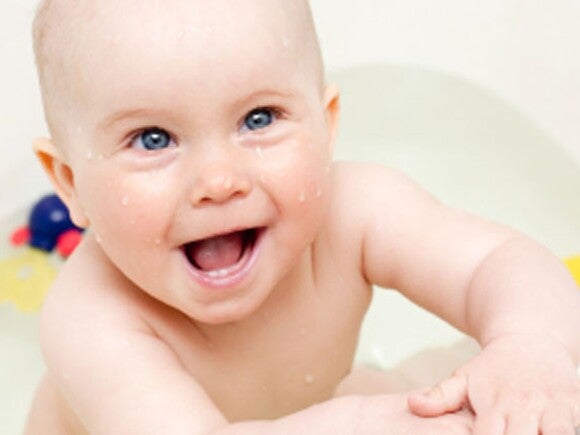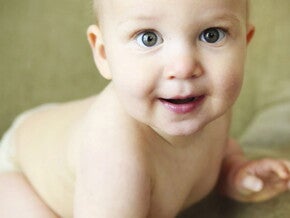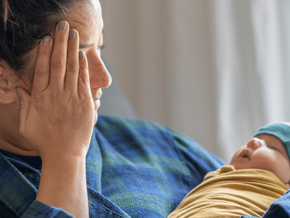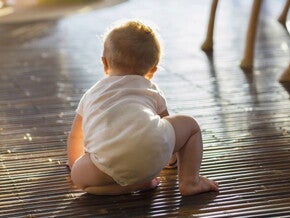
Bathing Baby
Your baby will love a nice warm bath and if not, be patient – it won’t take long and they will and won’t want to get out! Water is warm and soothing and bathing offers a lovely opportunity for close interaction between you and your baby. Here are ten tips to make the bathing experience enjoyable and effective.
Ten Tips for Bath Time
1. How often? The frequency depends on the climate you live in, your baby’s health, age and the time of year. During the early weeks your baby won’t need a bath every day – top to toe sponge baths are a good alternative. A daily bath will be more important when your baby enjoys a routine and starts to eat solid foods.
2. Be prepared: Collect items needed for bath time such as bath wash, towels, wash cloth, new nappy and clothes and other cleaning items. Keep them close at hand before you begin the bath.
3. Water temperature: Your baby can’t regulate body temperature as well as you can. It is important to set up the bath in a warm room free of draft. Make the water body temperature – check before you place your baby in the water by dipping your elbow in. Your elbow should not discolour and feel neither hot nor cold.
4. Face, eyes and ears first: While wrapped in the towel and laying on the change mat, clean your baby’s eyes, ears and face.
5. Get a grip: Your baby will be slippery when wet. Use both hands when taking your baby to and from the bath. To keep your baby from slipping in the water, lay a towel on the bottom to act as a soft bath mat. NEVER let go of your baby while in the bathwater.
6. Choose a mild soap: Your baby’s skin is very sensitive – products used on your baby’s skin need to be natural and gentle. You can add bath oil (fragrance free) to the water to help prevent skin drying. Babies don’t need soaps and shampoos, you can just use water. Once your baby is on the move, you may wish to use non-fragrant, natural bath wash, oils, moisturisers and shampoos 1-2 times per week.
7. Hair care: Until your baby is several months old or actually has hair, shampooing won’t be necessary. Tilt their head backwards to help keep drips out of your baby’s eyes and use a mild, natural baby shampoo.
8. Cradle cap care: For the first few months you may notice little flakes or moist crusty bits on your baby’s scalp – this is cradle cap. Remove flakes with regular brushing and combing after a thorough towel dry.
9. Pat dry: When bath time is done, bundle up your baby in a clean, soft towel and dry them off with gentle patting not rubbing movements. Enjoy the wonderful fresh smell and beauty of your clean, relaxed baby.
10. Make bath time special: Bathing is necessary for good hygiene but it is also a special time to build an intimate bond between you and your baby. Smile, relax and enjoy the experience with them.
Umbilical Stump Care
For the first 24- 48 hours after birth your baby’s umbilical cord stump remains clamped. The cord stump tissue changes in appearance (darker and dryer) and odour until the point of separation.
It may have an offensive odour just before the stump falls off and this may be anywhere between a week or two. To care for the umbilical cord stump have the following available:
- Cotton tip applicators
- Cotton balls or gauze
- Clean water with sea salt or a normal saline solution
Thorough hand washing must be carried out before and after cord care.
Clean and dry the cord area whenever contaminated by urine or poo. Observe and clean the umbilical area when necessary until healing is complete. If there is any inflammation of the surrounding skin cleanse with normal saline and apply a natural barrier cream.
If there is any clear discharge or weeping from the umbilical region after the cord stump has fallen off, cleanse with normal saline or cool boiled water and keep dry.
Continue to air and keep dry and seek professional advice if the area continues to weep or bleed after the dried cord stump has fallen off.
Cleaning Baby’s Eyes
Clean your baby’s eyes using a couple of cotton balls or soft wipe. Moisten them in the prepared bath water.
Wipe the eye area firmly but gently from the nose area to the outside. Use another moistened cotton ball and do the other eye.
Sticky eyes, eyes that are weeping and stuck together at times, require more frequent cleaning and are not uncommon in babies. They are usually due to blocked tear ducts. Eyes can remain sticky for several weeks and often months despite regular cleansing. Seek professional assessment if there is any change in discharge or the eye becomes red.
Cleaning Baby’s Ears
Ear wax is formed in your baby’s outer ear canal and travels towards the outer ear edges with jaw movement. Its purpose is to assist in natural ear cleaning and lubrication and protects the ear from dust and dirt when they get in. Problems with hearing can occur if too much earwax builds up in the inner ear canal.
Only clean your baby’s ears using a moistened cotton wool ball or soft wipe around the outer ear folds and behind the ear. NEVER put a cotton bud or other narrow implement inside the ear canal – you can perforate the ear drum.
Finger Nail Care
You will notice your baby has very soft but often very long finger nails that grow quickly.
It is important to never chew nails off or rip them off as this can damage the nail cuticle and increase the risk of bacterial infection as it will be an open wound. Instead, use either baby clippers or baby blunt ended scissors.
It is often a two person job to perform. A good time is when your baby is feeding or resting in someone’s arms.
Cut straight across the nail tip, not down towards the nail bed.
Covering the hands with mittens, socks or folding over the cuffs built in to some playsuits will help prevent scratch wounds.
Toe Nail Care
Have you noticed your baby’s toe nails grow in a slightly curved angle and often look like an ingrown toe nail? They are soft and will not cause damage but they can get aggravated and inflamed from continually wearing socks, booties or suits with feet in them. Ensure your baby gets some time to air their feet. Dab red inflamed areas with a suitable antibacterial lotion such as tea tree oil. Your baby’s feet grow very quickly. Check that their feet are not scrunched up in suits and socks that are too small.
Nose Cleaning and Sneezing
It is important to keep your baby’s nasal passages clear. Your baby cannot blow their nose or cough effectively so often sneezes regularly to clear these air passages. Keeping nasal secretions moist helps them to dislodge. You can achieve this with regular feeding and a little water or normal saline squirt up the nose. A humidifier in the sleeping area is useful in dry climates or in heated or air-conditioned homes. When nasal secretions are moist, use a little rubber bulb purchased from a pharmacy or twist the end of a tissue and gently grip any snot at the base of the nose. Never use cotton buds (or anything for that matter) up into the nose.
For advice on how to keep your baby happy and engaged during bath time when their older, read our guide on Ways to Make Bath Time Exciting for Toddlers.
Related articles


















